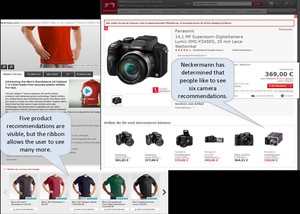Success with Best Practices for Targeted Merchandising
Unlocking the Power of Recommendation Engines
Recommendation technology has made targeted merchandising accessible to merchants of any size. We’ve identified three best practices for targeted merchandising, plus the eight principles that will guide you in applying the practices. Our best practices can be applied to your targeted merchandising whatever technology you are using: we bring you principles and tactics that are solid and time tested.
NETTING IT OUT
Targeted merchandising has the potential to improve both the customer experience and merchant results. The customer gets the most relevant content at every turn, and the merchant gets a happier, “spendier” consumer; exposure for all products, not just the most popular; and more qualified opportunities to present high-margin or high-inventory items. Tailored recommendations have been shown to be roughly three times as effective as static or generic recommendations. Targeted merchandising is a relatively new discipline and is not well understood or consistently practiced by merchants. People are hungry for best practices guidance. But just knowing what the best practices are is not enough. You need a set of principles that enable you to adapt the practices to your business, your goals, your customers, your changing situation.
We’ve identified three best practices for targeted merchandising, plus eight principles that will guide you in applying these practices. Our best practices can be applied to your targeted merchandising whatever technology you are using: we bring you principles and tactics that are solid and time tested.
(Click on image to enlarge.)
© 2011 Patricia Seybold Group, Underarmour.com, Neckermann.de
Illustration 1. The right number of recommendations depends on your business. For Underarmour.com, the right number is controlled by customers as they manipulate the ribbon of product images. For Neckermann.de, the right number of cameras to suggest is six.
TARGETED MERCHANDISING, PERSONALIZATION, AND RECOMMENDATION SYSTEMS
Targeted Merchandising Benefits
Merchandising is the practice of maximizing sales by leveraging product design, packaging, pricing, display, and, most importantly, selection. Targeted merchandising selects content (including products and offers) for consumers based on traits, such as consumer context or behavior, or based on rules set by merchandisers. Targeted merchandising improves the customer experience and merchant results.
Targeted merchandising has four big benefits:
- It improves the customer experience by optimizing the customer’s time and engaging the customer with the most relevant and interesting content.
- It maximizes retailers’ scarcest resource: customer attention.
- It increases retailers’ chief goal: revenue.
- It improves margin by automating the promotion of all items in the catalog, not just the most popular.
Recommendations Work
Currently, the recommendation engine is the most effective technology for achieving the benefits of targeted merchandising. The recent arrival of cloud-based solutions which collect and analyze user behavior, identify relevant and engaging recommendations, and automate much of the process of selecting content, testing impact, and analyzing results have made recommendation engines (or recommender systems, or personalization systems) affordable for any size merchant.
Acquiring and keeping customers requires engaging and entertaining them the instant they appear at your electronic door, and then guiding them smoothly through the purchase path. Merchandising is the umbrella term for the arts and sciences involved. Targeted merchandising selects the most engaging content based on the visitor’s context, behavior, or history. Done effectively, it can triple the conversion rate. It exposes customers to content that is most relevant to them, improves the customer experience, and maximizes revenue and margin from advertising.
Whereas past efforts at personalization have not been very effective or accessible, today there is no doubt that recommender systems work, driving significant revenue (as much as 20 percent). With the prevalence of the SaaS model, which reduces up-front effort and cost, recommendations are accessible to merchants of all sizes and can be added to any retailer’s customer interactions.
Targeting vs. Personalization
Targeted merchandising selects content (including products and offers) for consumers based on traits such as consumer context or behavior, or based on rules set by merchandisers. The targeted consumer is anonymous. Without a customer profile, there is no access to data on past interactions. Personalization implies that the consumer is not entirely anonymous: a profile has been collected that includes traits such as demographics, purchase history, and behavior, and this profile is used by the algorithms that select the content to be presented. While registering and logging in increase the available data, the consumer is most often identified by web browser cookies and an associated identification number. Without registration, it is unlikely the profile will contain user information such as name and address, so consumer anonymity is usually retained.
Our best practices can be applied to your targeted merchandising whatever technology you are using: we bring you principles and tactics that are solid and time tested.
WHAT ARE APPLICABLE BEST PRACTICES FOR MY SITUATION?
In Search of Best Practices Guidance that Can Be Applied and Tested
There are lots of examples of good ways to apply targeted merchandising techniques. But in examining them, you quickly realize that they are slippery. What works for one brand’s customers won’t necessarily work for your company’s customers.
What Are “Best Practices” for Recommendations?
Best practice information is pretty popular. Naturally we all want to know the right way to attack a problem. But much of the best practice information we’ve seen is very general or very specific, such as ...
Sign in to download the full article
0 comments
Be the first one to comment.




